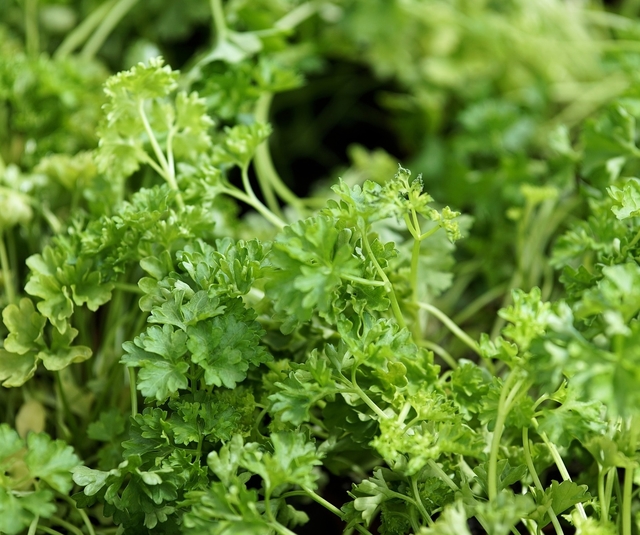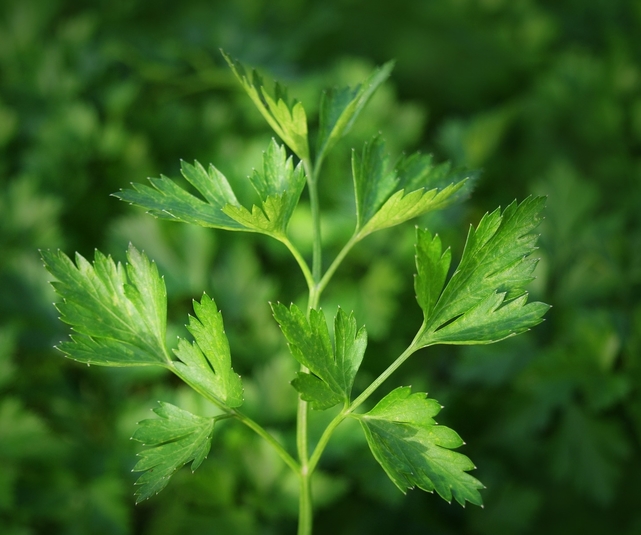Parsley is a tender herb with soft stems and leaves. It is popular for many reasons including its variety of uses, vitamin content and its ability to grow and give you a flavorful harvest even after a light snowfall. Parsley has a light, peppery flavor that complements other seasonings.
Types of Parsley
Curly Leaf Parsley. Deep curled leaves and attractive appearance. Only used as a garnish.
Flat Leaf Parsley (AKA Italian Parsley) Preferred by cooks for its flat, celery-like leaves. Pleasant tasting foliage can be eaten fresh or added to recipes. Single Leaf Italian Parsley has a rich flavor that is best for seasoning cooked dishes.
Giant of Italy Parsley. Huge, dark green leaves with great flavor. Strong, upright stems make this one of the best parsley varieties for fresh-market sales.
Starting Parsley from Seed
Parsley is slow to germinate, but after you do get it to the plant stage, it's not fussy at all. To speed up this process, soak or refrigerate the seeds for a day before sowing them.
Seed Longevity: 2-3 years.
Seed Sowing Depth: 1/4”.
Best Soil Temp for Germination: 65 – 85 degrees.
Days to Germination: 21+ days.
Spring Sowing
Direct sow 4-6 weeks before the last frost date or as soon as the soil can be worked, or sow indoors 6-8 weeks before the last frost date.
Winter Sowing
If you haven't tried winter sowing, you're in for a treat. This method is especially good for sowing herbs. Winter sowing is basically sowing seeds in the bottom of clear milk jugs in the winter, setting the milk jugs outside for the winter and leaving them there until the seeds germinate in the Spring.
For our article containing detailed information about Winter Sowing, click here
To watch our 30 minute video on how to winter sow, click here.
Other Sowing Tips
You can also start seeds in a pot in late summer and grow the plant outside until the first frost, then bring the plant indoors.
Growing Parsley
Plant Size: 12-18” Height.
Growing Soil Temperature: 60 – 65 degrees.
Spacing: 9-12”.
Container Size: 6-18” in diameter 12” deep.
For fresh parsley all winter long, transplant one or two plants in a 10” container in late Fall and grow in a sunny window.
Soil: Fertile, slightly acidic to slightly alkaline.
Watering: Light. Parsley has shallow roots.
Light/Sun: Full sun to light shade.
Fertilizer: None.
Good Companions: Asparagus, corn, pepper, tomato.
Other Care Tips:
Keep roots cool and moist by mulching.
In September, cut back plants set out in spring to promote new foliage.
Dividing Parsley
Dig up the Parsley plant. Locate the older growth which will have a slightly darker hue. This growth is vital to the plant. Divide into thirds and replant at the same depth. Do not harvest sections again for at least 3 weeks.
Cuttings of Parsley
Take cuttings in spring when new growth is several inches in length. Side shoots of 4" in length are perfect. Cut the stem at an angle and remove lower leaves leaving an inch or two of the stem bare. Plant cutting bare side down into a well-drained soil mix. No fertilizer is needed at this stage.
Wrap the container in plastic to keep in humidity. Avoid having the leaves touch the plastic. Place the pot in light but out of direct light. Keep soil moist but never soggy. Remove the plastic when cutting grows roots. A light tug that yields some resistance will let you know that roots have formed.
Harvesting Parsley
Harvest Parsley as needed, starting with the larger outer leaves. You can also harvest the long stems with the leaf blades. You can cut above the soil level for a bunch and it will grow new foliage.
Harvesting Parsley Seed
Parsley does not go to seed the first year. Harvest the Parsley seeds of second-year plants when they have turned dark brown. If the seeds are harvested earlier, they may not be viable. Shake seeds off the seed heads and into a paper bag to dry. You can also pluck out seeds as they turn brown as they tend to ripen at separate times.
Storing Parsley
Fresh
Bouquet Storage
This method works well for tender herbs with soft stems and leaves.
- Clean and thoroughly dry the herb.
- Trim the end of the stems and remove any wilted or browned leaves.
- Fill a Mason jar or clear glass with 1" of water.
- Place the herbs in the jar like a bouquet of flowers
- Loosely cover with a plastic bag or cling wrap. Label and store in the fridge.
Parsley will stay fresh in the fridge with this method for 3 weeks.
Freezing Parsley
For best results, use frozen Parsley within 1-2 years.
By freezing herbs, you will lose some of the herb's texture but preserve the flavor.
Here are a few freezing options to consider:
Tray Freeze
Spread herb onto a cookie sheet on a single layer. Freeze in the freezer, then transfer the herbs into a labeled freezer bag to store. Since the leaves are frozen separately, you can easily remove the amount you need.
Ice Cube Trays
Clean and thoroughly dry herbs. Mince and pack herbs into ice cube trays 3/4 full. Add water to fill and freeze. Transfer frozen cubes into a labeled freezer bag to store.
Flat Freezer Bag
Clean and thoroughly dry herbs. Chop herb into 1/2" pieces, place in a labeled freezer bag. Squeeze out the air, lay flat and freeze.
Drying Parsley
Hang to Dry
Pick your herbs in bunches right before you intend to store them. Tie the bottom of the bunch together with twine and hang upside down to dry in a dry, low humidity area. For added protection against dust, you can put the bundles inside paper bags with plenty of holes for ventilation. When the herbs are dry, the leaves will crumble easily between your fingers. Store in an air tight container. For best results, use dried Parsley within 1-2 years.
Dehydrate Parsley in Dehydrator
Using Parsley
Parsley perks up salads, soups, meatballs, and poultry stuffing.
It is most often used in sauces, salads, and sprinkled over dishes at the end of cooking for a flash of green and fresh taste.
~~~~~~~~~~~~~~~~~~~~~~~~~~~~~~~~~~~~~~~~~~~~~~~~~~~~~~~~~~~~~
Growing your own herbs is fun, easy, more healthy than the herbs shipped to grocery stores, and what's best, saves you tons of money! Try it today.
~~~~~~~~~~~~~~~~~~~~~~~~~~~~~~~~~~~~~~~~~~~~~~~~~~~~~
This post may contain some Amazon Associate links meaning that I will get a small compensation at no expense to you if you purchase something from this blog.
























